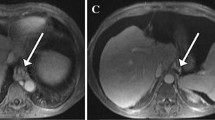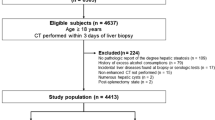Abstract
Purpose
To establish measurement quality criteria for the noninvasive assessment of clinically significant portal hypertension (CSPH) in patients with cirrhosis using CT-based liver surface nodularity (LSN) measurements.
Methods
Seventy-four consecutive patients with cirrhosis (mean 62 ± 13 years), including 30 with CSPH (41%), underwent CT and hepatic venous pressure gradient measurements. Three independent readers performed 15 LSN measurements/patient using dedicated software. LSN was computed based on the median and means of one to 15 measurements. Accuracy for diagnosing CSPH was assessed using receiver operating characteristic (ROC) curve analysis. Variability was assessed by the intra-class correlation coefficient (ICC) and the Bland–Altman plot (BA). Quality criteria were identified to maximize the accuracy of LSN and minimize variability.
Results
The area under the (AU) ROCs of mean and median LSN measurements based on one to 15 measurements ranged from 0.79 ± 0.05 to 0.91 ± 0.04 and 0.86 ± 0.04 to 0.91 ± 0.03, respectively, with no difference on pair-wise comparisons (all p > 0.05). AUROCs of LSN increased from one to eight and leveled off between eight and 15 measurements. Inter- and intra-reader variability decreased from one to 15 measurements, with only slight improvement after more than eight measurements. Intra- and inter-observer agreements were excellent with eight measurements (ICC = 0.90 [95%CI 0.84–0.94], and ICC = 0.93 [95%CI 0.89–0.95], respectively), and variability for intra-observer and inter-observer agreement was low (BA bias 4.2% (95% limits of agreement [LoA] [− 15.3; + 23.7%]) and 4.8% LoA [ − 17.5; + 27.1%], respectively).
Conclusions
CT-based LSN measurement is highly reproducible and accurate. We suggest using at least 8 valid measurements to determine the mean LSN value for the detection of CSPH.





Similar content being viewed by others
References
Groszmann RJ, Wongcharatrawee S (2004) The hepatic venous pressure gradient: anything worth doing should be done right. Hepatology 39(2):280–282.
De Franchis R (2000) Updating consensus in portal hypertension: report of the Baveno III Consensus Workshop on definitions, methodology and therapeutic strategies in portal hypertension. J Hepatol 33(5):846-22.
Berzigotti, A (2017) Non-invasive evaluation of portal hypertension using ultrasound elastography. J Hepatol 67(2):399-411.
Berzigotti A, Seijo S, Arena U et al (2013) Elastography, spleen size, and platelet count identify portal hypertension in patients with compensated cirrhosis. Gastroenterology 144:102–111.
Jansen C, Bogs C, Verlinden W et al (2016) Algorithm to rule out clinically significant portal hypertension combining Shear-wave elastography of liver and spleen: a prospective multicentre study. Gut 65(6):1057-8
Sartoris R, Rautou PE, Elkrief L et al (2018) Quantification of Liver Surface Nodularity at CT: Utility for Detection of Portal Hypertension. Radiology. 289(3):698-707.
De Vos N, Sartoris R, Cauchy F et al (2019) Performance of liver surface nodularity quantification for the diagnosis of portal hypertension in patients with cirrhosis: comparison between MRI with hepatobiliary phase sequences and CT. Abdom Radiol 45(2):365-372.
Degos F, Perez P, Roche B, Mahmoudi A, Asselineau J, Voitot H et al (2010) Diagnostic accuracy of FibroScan and comparison to liver fibrosis biomarkers in chronic viral hepatitis: a multicenter prospective study (theFIBROSTIC study). J Hepatol 53:1013-1021
Zarski JP, Sturm N, Guechot J, Paris A, Zafrani ES, Asselah T et al (2012) Comparison of 9 blood tests and transient elastography for liver fibrosis in chronic hepatitis C: the ANRS HCEP-23 study. J Hepatol 56:55-62.
Smith AD, Branch CR, Zand K et al (2016) Liver Surface Nodularity Quantification from Routine CT Images as a Biomarker for Detection and Evaluation of Cirrhosis. Radiology 280(3):771-81.
Pickhardt PJ, Malecki K, Kloke J, Lubner MG (2016) Accuracy of Liver Surface Nodularity Quantification on MDCT as a Noninvasive Biomarker for Staging Hepatic Fibrosis. Am J Roentgenol 207(6):1194-1199.
Lubner MG, Jones D, Said A et al (2018) Accuracy of liver surface nodularity quantification on MDCT for staging hepatic fibrosis in patients with hepatitis C virus. Abdom Radiol 43(11):2980-2986.
Pickhardt PJ, Graffy PM, Said A, Jones D, Welsh B, Zea R, Lubner MG (2019) Multiparametric CT for Noninvasive staging of hepatitis C Virus–Related Liver Fibrosis: Correlation with the Histopathologic Fibrosis Score. Am J Roentgenol 212:547-553.
Smith AD, Zand KA, Florez E, et al (2017) Liver surface nodularity score allows prediction of cirrhosis decompensation and death. Radiology 283(3):711–722.
Besa C, Wagner M, Lo G, Gordic S, et al (2018) Detection of liver fibrosis using qualitative and quantitative MR elastography compared to liver surface nodularity measurement, gadoxetic acid uptake, and serum markers. J Magn Reson Imaging 47(6):1552-1561.
Lo GC, Besa C, King MJ, et al (2017) Feasibility and reproducibility of liver surface nodularity quantification for the assessment of liver cirrhosis using CT and MRI. Eur J Radiol Open 21;4:95-100.
Elkrief L, Ronot M, Andrade F et al (2018) Non-invasive evaluation of portal hypertension using shear-wave elastography: analysis of two algorithms combining liver and spleen stiffness in 191 patients with cirrhosis. Aliment Pharmacol Ther 47(5):621-630.
Procopet B, Berzigotti A, Abraldes JG et al (2015) Real-time shear-wave elastography: applicability, reliability and accuracy for clinically significant portal hypertension. J Hepatol. 62(5):1068-75.
Ferraioli G, Tinelli C, Zicchetti M et al (2012) Reproducibility of real-time shear wave elastography in the evaluation of liver elasticity. Eur J Radiol. 81(11):3102-6.
Smith A, Varney E, Zand K, et al (2018) Precision analysis of a quantitative CT liver surface nodularity score. Abdom Radiol 43(12):3307-3316
Funding
None.
Author information
Authors and Affiliations
Corresponding author
Ethics declarations
Conflict of interest
The authors declare that they have no competing interests.
Ethical approval
IRB approved with a waiver for informed consent.
Additional information
Publisher's Note
Springer Nature remains neutral with regard to jurisdictional claims in published maps and institutional affiliations.
Rights and permissions
About this article
Cite this article
Sartoris, R., Lazareth, M., Nivolli, A. et al. CT-based liver surface nodularity for the detection of clinically significant portal hypertension: defining measurement quality criteria. Abdom Radiol 45, 2755–2763 (2020). https://doi.org/10.1007/s00261-020-02519-1
Published:
Issue Date:
DOI: https://doi.org/10.1007/s00261-020-02519-1




